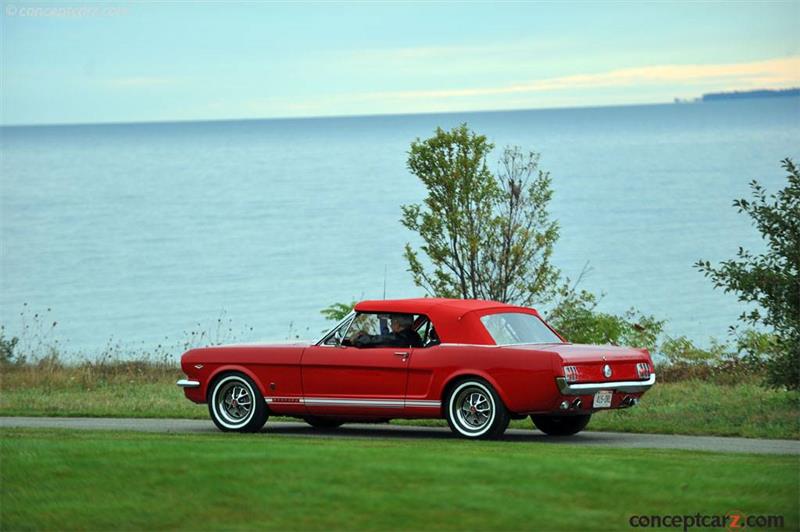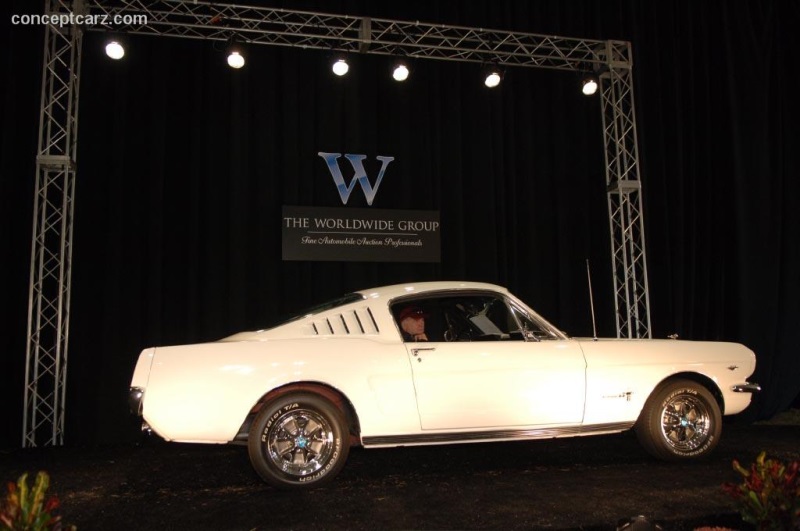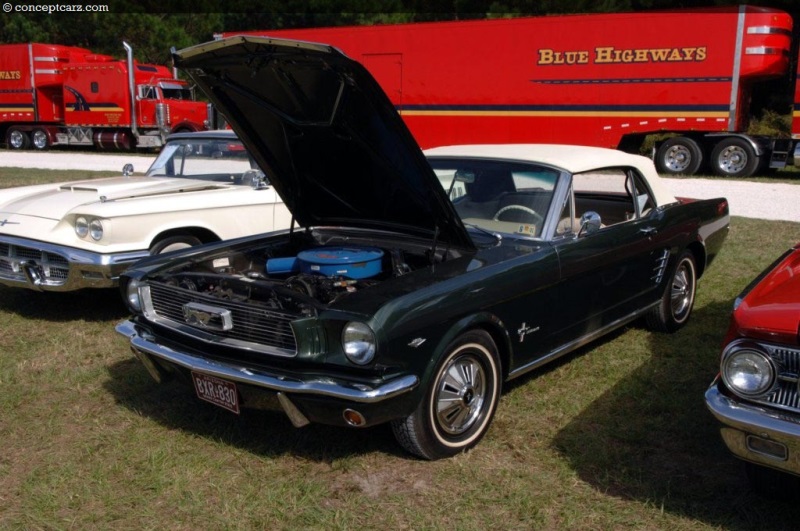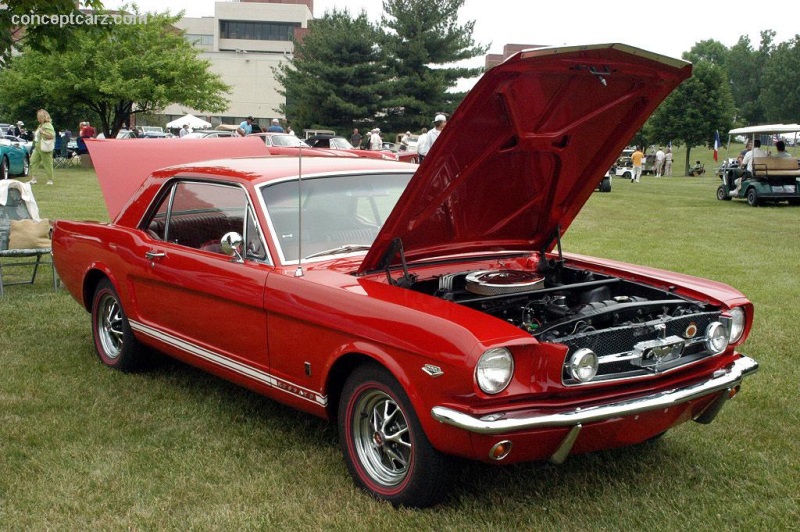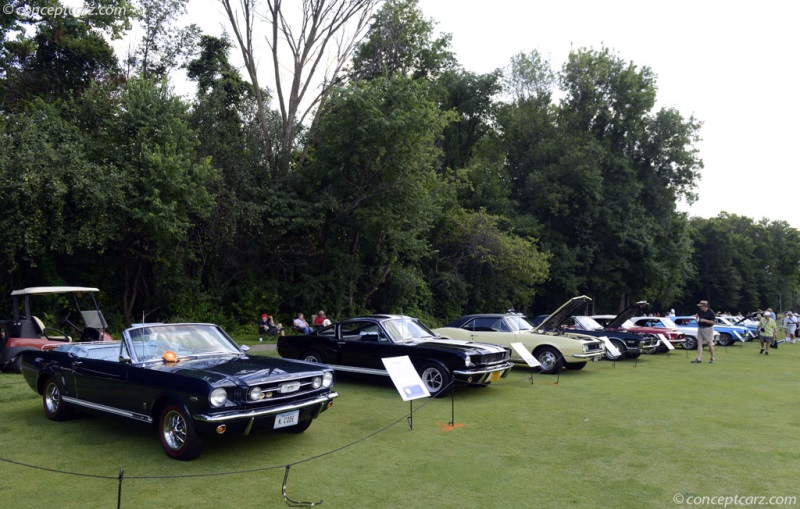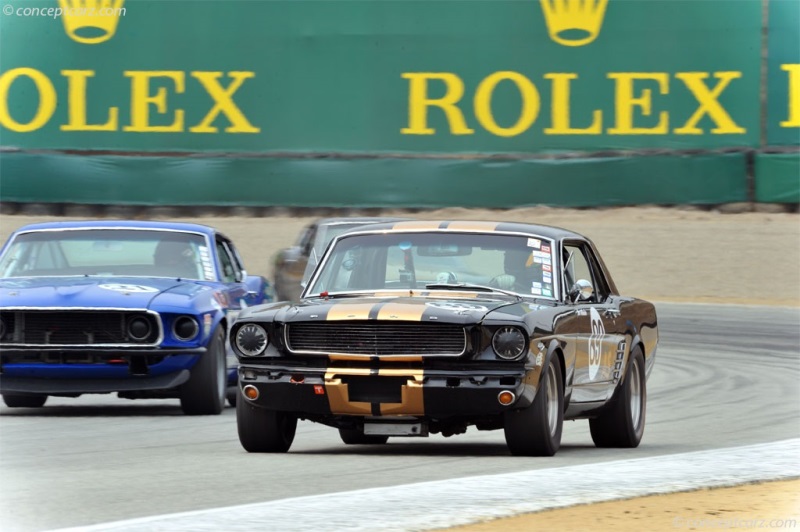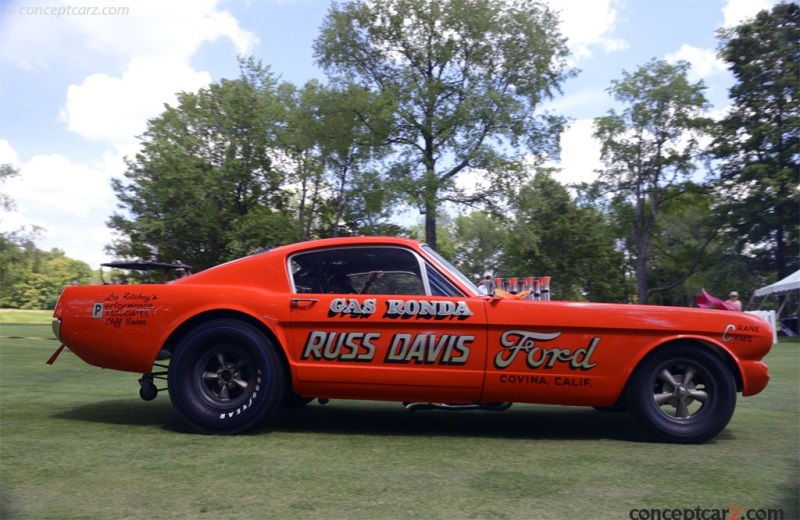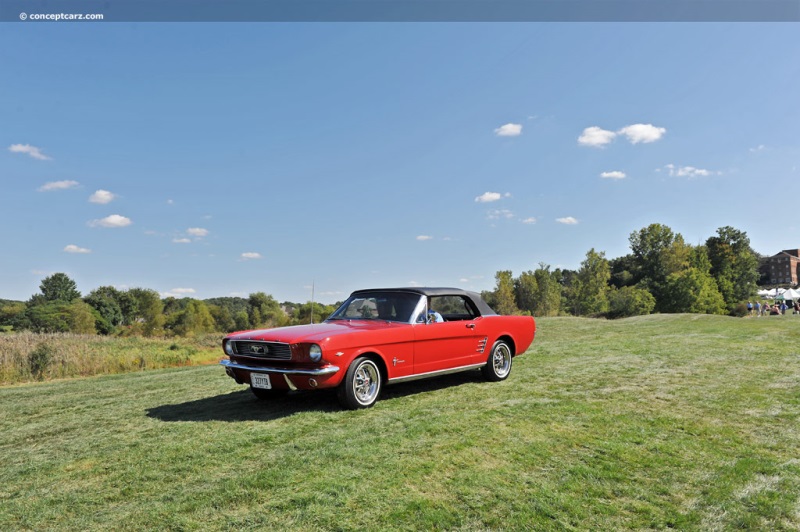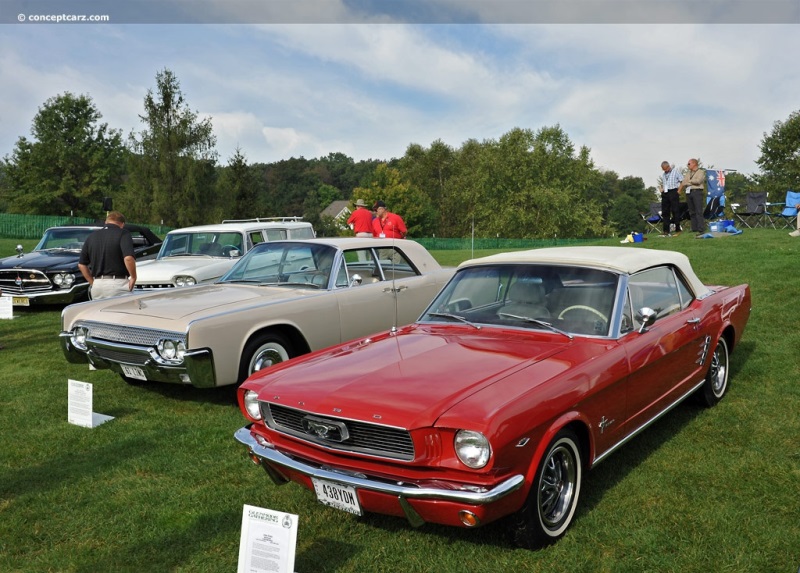1966 Ford Mustang Navigation
The Ford Mustang had firmly established itself as a household name by 1966, with its perfect proportions, attractive styling, and a seemingly endless array of options allowing it to transcend generations, and its affordability meant it was available to anyone with a steady paycheck. 
Convertible
View info and historyThe Ford Mustang set a sales record when it was introduced on April 17th, 1964, at the New York World's Fair. It not only took the world by storm and caused a sensation but created an entirely new market segment affectionately dubbed Pony Cars. Over 22,000 orders were received on launch day, over 70,000 examples were sold in the first 30 days of production, and 400,000 were sold in its first year with 1.3 million manufactured over the first three years of production. For 1966, Ford designers gave the Mustang carefully planned, subtle updates as little was needed since sales were still strong (for 1966, it was the third best-selling nameplate in the United States and accounted for 7.1 percent of all automobiles sold in the United States). Changes were made to the grille, which had a floating Mustang emblem in the center. On the rear fender was new trim, with three chrome steps within the simulated scoop. Distinguishable differences between the 1965 and 1966 Mustang:
- The 1966 Mustangs had a 'slotted' style on the front grille, while the 1966 used a 'honeycomb' pattern
- Both 1965 and 1966 Mustangs had the 'Horse and Corral' emblem on the grille, but the 1965s had four bars extending from each side of the corral, while the 1966s did not have these bars
- The emblem on 1964 and 1965 Mustangs had a single vertical piece of chrome; the 1966 models had a smaller emblem (smaller in height) with three horizontal bars extending from the design, resembling an 'E.'
Hardtop CoupeThe 1966 model year marked the last year of the original styling of the Mustang. Body Styles, Pricing, and Production
Body styles included a fastback coupe, a hardtop coupe, and a convertible. The most popular was the hardtop coupe which accounted for 499,751 sales with a base price of $2,415. 72,119 examples of the convertible were built with a base price of $2,650, and 35,698 of the fastback coupe ($2,600). Ford introduced the 1966 Mustang on October 1, 1965 (the same day as other Ford model introductions) and would build 607,568 examples that year. Engines and Transmissions
The base engine was a 200 cubic-inch Thriftpower inline six-cylinder unit that offered 120 horsepower at 4,400 RPM and 190 lb-ft of torque at 2,400 RPM. It had overhead valves, a cast iron block, a 9.2:1 compression ratio, hydraulic valve lifters, seven main bearings, and a Ford (Autolite) one-barrel carburetor. The bore measured 3.68 inches and the stroke of 3.12 inches.
Hardtop CoupeThe 289 cubic-inch V8, depending on configuration, produced between 200 and 275 horsepower. It had overhead valves, hydraulic valve lifters, a cast iron block, five main bearings, a bore of 4 inches and a stroke of 2.87 inches. With a two-barrel carburetor, the 4.7-liter small block produced 200 bhp at 4,400 RPM and 282 lb-ft of torque at 2,400 RPM. With a four-barrel carburetor, it delivered 225 bhp at 4,800 RPM and 305 lb-ft of torque at 3,200 RPM. The 4.7-liter small block HiPo V8 with a four-barrel carburetor and 10.5:1 compression produced 271 bhp at 6,00 RPM and 312 lb-ft of torque at 3,400 RPM. The standard transmission was a three-speed manual. Ford's new C4 'Cruise-O-Matic' three-speed automatic transmission was available for the 225 hp V8 engine, and the 289 'HiPo' K-code engine was also offered with a C4 transmission.Dimensions
The 1966 Ford Mustang had a 108-inch wheelbase with an overall length of 181.6 inches, a width of 68.2 inches, and stood 51.2 inches tall. It had a curb weight of 2,445 lbs, but this figure fluctuated depending on options and mechanical configurations. Standard Equipment
Ford removed the Falcon instrument cluster used on previous Mustangs and replaced it with round gauges and padded sun visors (previous optional features). Adjustable driver and passenger bucket seats were standard, as was an AM radio, a floor-mounted shifter in a variety of color options, a heater and defroster, front and rear seat belts, and a padded instrument panel. In front of the driver was a Sports-type steering wheel and a five-dial instrument cluster. Full carpeting was done throughout the interior and the front bucket seats had pleated vinyl upholstery. There were electric wipers, emergency flashers, back-up lamps, door courtesy lights, left-hand door outside rearview mirror, full wheel covers, and rocker panel moldings.
Hardtop CoupeThe standard 200 CID inline six-cylinder engine was paired with a three-speed manual transmission. The base V8 engine was the 289 CID with 200 horsepower. The fastback coupe body style came standard with Silent-Flo ventilation. Safety features were added in 1966 to comply with regulations, including seat belts, emergency flashers, windshield washers, electric wipers, and a padded instrument panel.Options and Packages
The 1966 Mustang was offered with a wider selection of paint and interior color options, along with an AM/eight-track sound system, and one of the first AM/FM mono automobile radios. The extensive list of options included air conditioning, manual disc brakes, deluxe steering wheel simulated woodgrain rim, full-length center console, rear deck luggage (not on fastback), stereo tape player, radio and antenna, accent striping, simulated wire wheel covers, and much more.
Fastback Coupe
View info and historyBuyers could further option the Mustang from the factory to their specific needs, including the popular GT Equipment Group available across all three Mustang body styles, including the convertible, 'notchback' coupe and 2+2 fastback. Available with high-performance V8 engines, GT equipment included dual exhaust, disc brakes, GT racing stripes, special ornamentation, and fog lamps.Nearly 63 percent of 1966 Mustangs were equipped with automatic transmissions and just 7.1 percent received four-speed manual units. Nearly every 1966 Mustang (98.8 percent) received a heater, and almost 29 percent had power steering. Just 6.7 percent had disc brakes, 3.3 percent had power brakes, 5 percent had dual exhaust, 2.6 percent had limited-slip differentials, and 9.5 percent had vinyl tops.The Special Handling Package, available with the 200 hp and 225 hp V8 engines, improved the front and rear spring rate, larger shocks, larger diameter stabilizer bar, and 22:1 overall steering ratio. 
Fastback CoupeThe Visibility Group had a remote control outside rearview mirror, a day/night inside mirror, and two-speed electric wipers. Décor Interior, also commonly known as the 'Pony' interior, adds uniquely shaped bucket seats with embossed running horses in the seat backs, a three-spoke steering wheel, molded door panels with unique door handles, and wood-grain trim.A total of 33 examples of the High Country Special limited edition were sold in Colorado, Wyoming, and Nebraska.
Hardtop CoupeThe Sprint 200 Limited Edition was a specially equipped and priced hardtop that celebrated Ford's selling one million Mustangs in 1966. Ford sold its one millionth Mustang on March 2, 1966. Even though the Sprint 200 package celebrated a production milestone, it was also meant as a distraction, luring buyers away from the 289 CID V8, and towards the 200 CID six-cylinder unit. Ford was running short of the 289 but had a surplus of 200 CID six due to dismal sales of the newly-redesigned Falcon for 1966 (which came standard with the six). The Ford Mustang Sprint 200 came with the 200 CID Six with a chrome air cleaner with a 'Sprint 200' decal on the cover, a chrome oil-filler cap, and either a manual or automatic transmission. Approximately 75% of the Sprint 200 Mustangs built in 1966 received the 'B' automatics (the manuals were known as the 'A'). The exterior was devoid of the chrome rear quarter ornamentation, added painted side accent stripes that matched the car's interior, and rode on a set of deluxe 48 spoke, blue center wire-style wheel covers. The interior had a center floor console with courtesy lights.Ford rarely used the 'Sprint' name in period advertising, and the package was sold mostly through three distinct promotions. Some were sold as early as November 1965, but most were sold in the early months of 1966, with a few as late as August 1966.
by Daniel Vaughan | Sep 2019
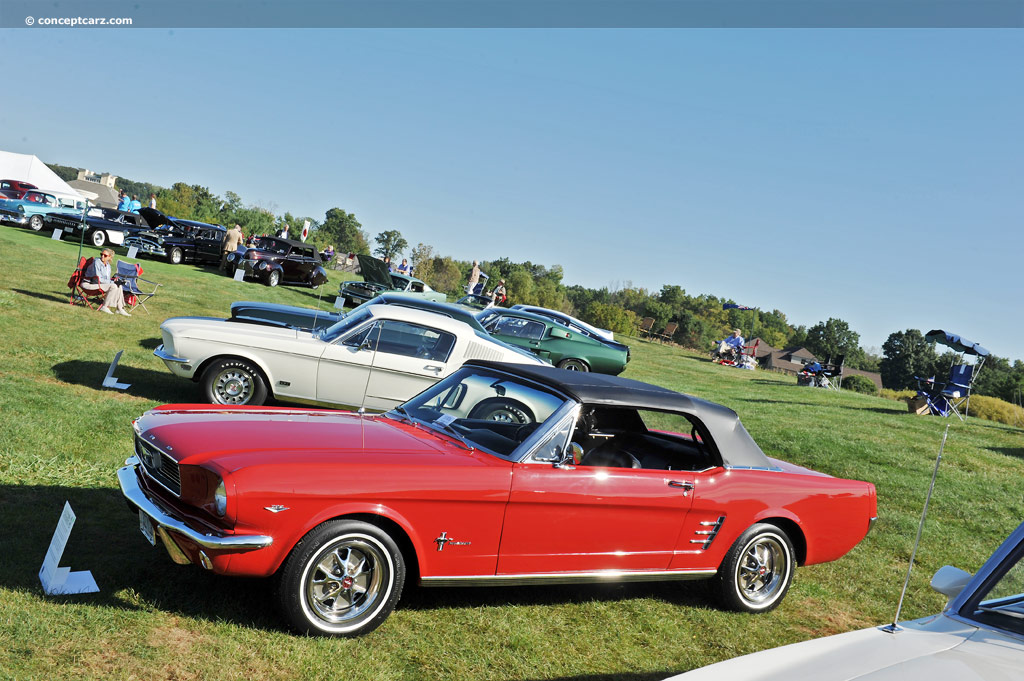
Convertible
View info and history
- The 1966 Mustangs had a 'slotted' style on the front grille, while the 1966 used a 'honeycomb' pattern
- Both 1965 and 1966 Mustangs had the 'Horse and Corral' emblem on the grille, but the 1965s had four bars extending from each side of the corral, while the 1966s did not have these bars
- The emblem on 1964 and 1965 Mustangs had a single vertical piece of chrome; the 1966 models had a smaller emblem (smaller in height) with three horizontal bars extending from the design, resembling an 'E.'
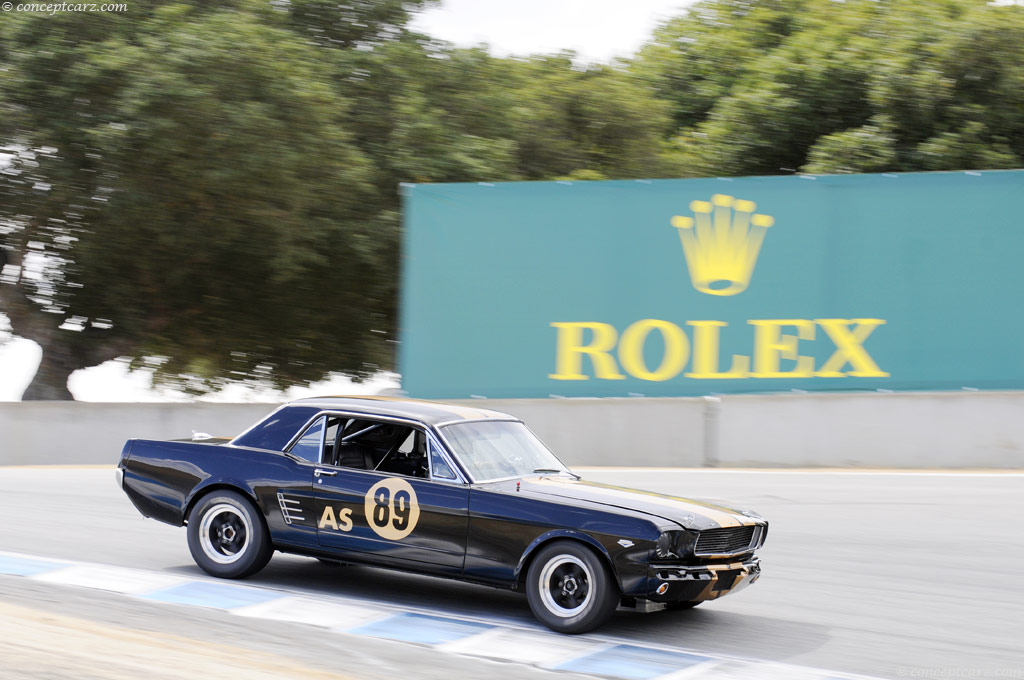
Hardtop Coupe
Body styles included a fastback coupe, a hardtop coupe, and a convertible. The most popular was the hardtop coupe which accounted for 499,751 sales with a base price of $2,415. 72,119 examples of the convertible were built with a base price of $2,650, and 35,698 of the fastback coupe ($2,600). Ford introduced the 1966 Mustang on October 1, 1965 (the same day as other Ford model introductions) and would build 607,568 examples that year. Engines and Transmissions
The base engine was a 200 cubic-inch Thriftpower inline six-cylinder unit that offered 120 horsepower at 4,400 RPM and 190 lb-ft of torque at 2,400 RPM. It had overhead valves, a cast iron block, a 9.2:1 compression ratio, hydraulic valve lifters, seven main bearings, and a Ford (Autolite) one-barrel carburetor. The bore measured 3.68 inches and the stroke of 3.12 inches.
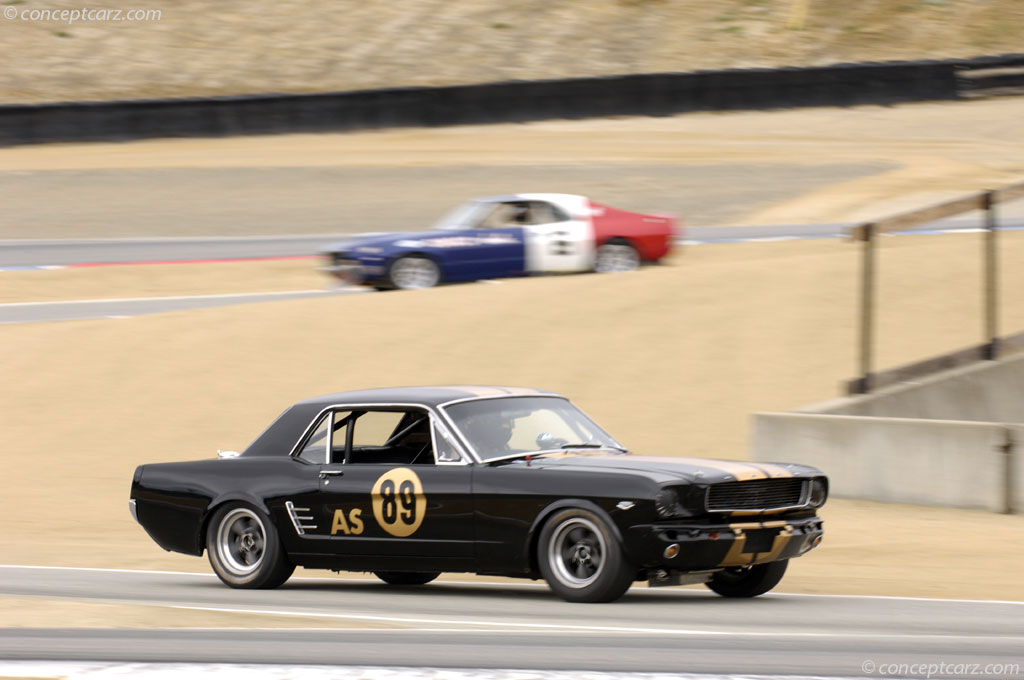
Hardtop Coupe
The 1966 Ford Mustang had a 108-inch wheelbase with an overall length of 181.6 inches, a width of 68.2 inches, and stood 51.2 inches tall. It had a curb weight of 2,445 lbs, but this figure fluctuated depending on options and mechanical configurations. Standard Equipment
Ford removed the Falcon instrument cluster used on previous Mustangs and replaced it with round gauges and padded sun visors (previous optional features). Adjustable driver and passenger bucket seats were standard, as was an AM radio, a floor-mounted shifter in a variety of color options, a heater and defroster, front and rear seat belts, and a padded instrument panel. In front of the driver was a Sports-type steering wheel and a five-dial instrument cluster. Full carpeting was done throughout the interior and the front bucket seats had pleated vinyl upholstery. There were electric wipers, emergency flashers, back-up lamps, door courtesy lights, left-hand door outside rearview mirror, full wheel covers, and rocker panel moldings.

Hardtop Coupe
The 1966 Mustang was offered with a wider selection of paint and interior color options, along with an AM/eight-track sound system, and one of the first AM/FM mono automobile radios. The extensive list of options included air conditioning, manual disc brakes, deluxe steering wheel simulated woodgrain rim, full-length center console, rear deck luggage (not on fastback), stereo tape player, radio and antenna, accent striping, simulated wire wheel covers, and much more.
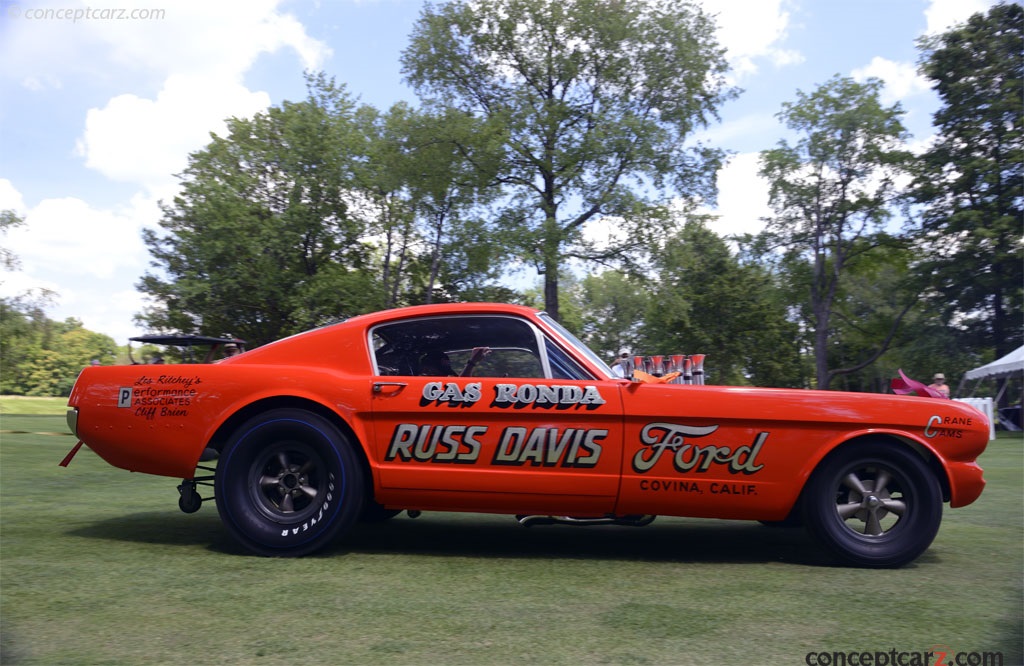
Fastback Coupe
View info and history
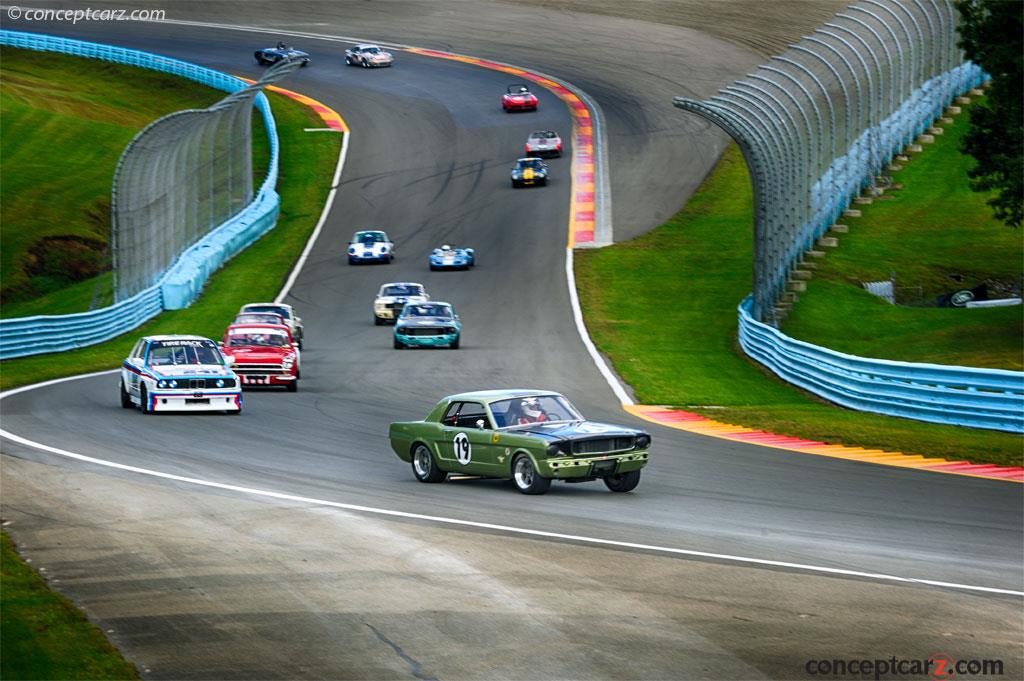
Fastback Coupe
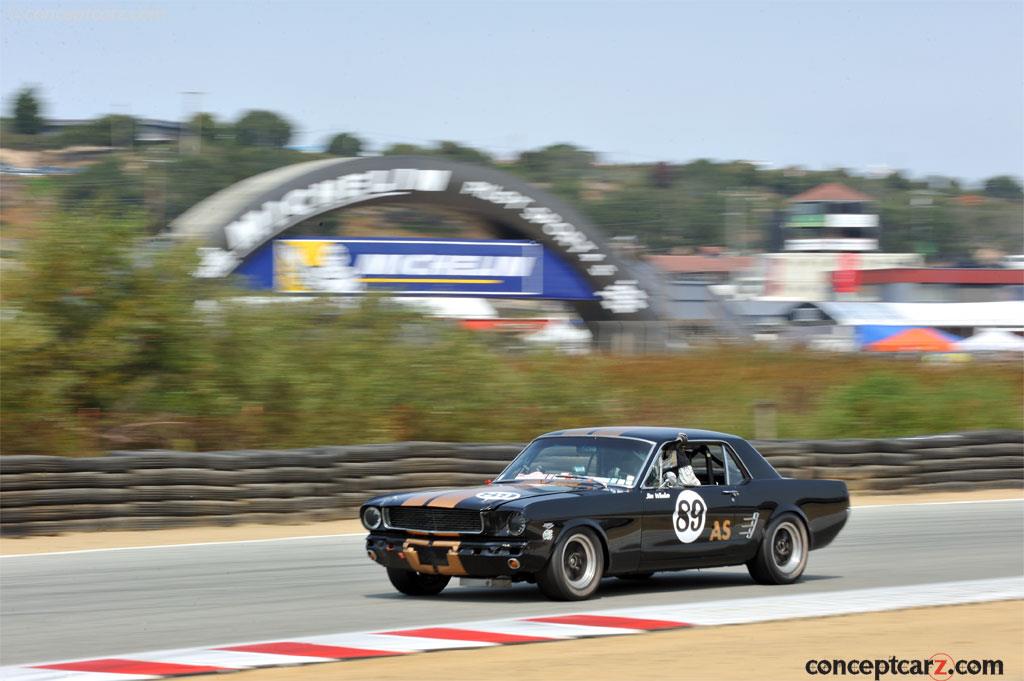
Hardtop Coupe
by Daniel Vaughan | Sep 2019
Related Reading : Ford Mustang History
The Mustang was introduced at the 1965 New York Worlds Fair, Mustang Mania instantly swept the country, and a new automotive market segment was created - the 22 or better known as the ponycar. Though its mechanical underpinnings descended from the Falcon, the Mustang was completely different. It was a compact, tight, clean package weighing in at a modest 2,550 pounds - a departure from the ever-enlarging....
Continue Reading >>
Continue Reading >>
Related Reading : Ford Mustang History
The Ford Mustang first appeared in 1964 and was immediately popular for its style and its capabilities. The largest engine offering of the time was the 289 V-8 K-code small block engine which was sufficient but enthusiasts wanted and demanded more power. The base engine was a six-cylinder power plant. The body style configurations included coupe, convertible and fastback. In its first year of....
Continue Reading >>
Continue Reading >>
Related Reading : Ford Mustang History
A pillar of American automotive lore, the Mustang is the vehicle the brought sporting dash and styling at a price that almost everyone could afford. Always extraordinarily attractive, the Mustang has been capturing the hearts of drivers for nearly 40 years. Introducing a whole new breed of automobile, the pony car, Ford wasnt content to stand on the sidelines while others jumped ahead. Rather than....
Continue Reading >>
Continue Reading >>
- 1966 Ford Mustang Menu
- Article
- Image gallery
- Valuation
- Specifications
- Profiles
- Recalls
- Production figures
Drag Racer Vehicles
Similarly Sized Vehicles
Ford
Similar Vehicles
Similar Automakers
Similarly Sized Vehicles
from 1966
- Aston Martin DB6
Bizzarrini 5300 Spyder S.I Prototipo
Ferrari 275 GTB
Ferrari 275 GTB Competition
Ferrari 275 GTS
Ferrari 330 GT
Ferrari 330 GT Navarro Special
Ford Mustang GT350
Ford Mustang GT350-R
Ford Mustang Hertz GT350
Similarly Priced Vehicles
- Chevrolet Corvair Series ($2,100-$2,700)
- Chevrolet Nova Series ($2,200-$2,500)
- AMC Marlin ($2,601-$2,601)
- Studebaker Cruiser ($2,545-$2,680)
- Datsun Fairlady 1600 ($2,545-$2,545)
- Ford Fairlane ($2,238-$3,066)
- Volkswagen Karmann-Ghia 1300 ($2,260-$2,500)
- Dodge Coronet ($2,265-$2,925)
- MG MGB MKI ($2,605-$3,095)
- Plymouth Belvedere ($2,275-$2,910)
Average Auction Sale: $29,699
1966 Ford Mustang Vehicle Profiles
Recent Vehicle Additions
Related Automotive News

How Ford Put A 1966 Mustang Atop The World'S Tallest Building
In October 1965, Ford and the management of the Empire State Building in New York collaborated to display a new Mustang convertible on the worlds highest observation deck
Ford engineers and technicians cut the car into four sections that would fit...

Barrett-Jackson Northeast Auction To Offer Incredible Mix Of Classic Ford Mustangs
UNCASVILLE, CONN. – June 11, 2019 – Barrett-Jackson, the Worlds Greatest Collector Car Auctions, will offer an incredible mix of classic Ford Mustangs during its 4th Annual Northeast Auction, June 26-29, 2019, at Mohegan Sun in Connecticut. When...

Subaru Announces Pricing On 2019 BRZ Sports Car
New Series.Gray limited edition of only 250
SUBARU STARLINK™ navigation system offers over-the-air updates
205-hp SUBARU BOXER® engine
Choice of 6-speed manual or 6-speed automatic transmission
Priced just %24200 more than previous model year
Sub...

Subaru Announces Pricing On 2018 BRZ Sports Car
Light weight sports car with ultra-low center of gravity
Starts just %24100 over 2017 model year
New infotainment and available navigation
Choice of 6-speed manual or 6-speed automatic transmission
Optional Performance Package
Subaru of America,...

GENERAL MOTORS GALORE AT MECUM KISSIMMEE 2016
69 Trans Am Convertibles, 69 ZL1s and Featured Corvettes at Auction, Jan. 15-24
Walworth, Wis. – Jan. 12, 2016 – As the worlds largest collector-car auction featuring 3,000 vehicles, Mecum Kissimmee is unequaled in its variety of mak...

SUBARU ANNOUNCES 2014 BRZ PRICING
BRZ sales up 200 percent YTD over 2013
Cherry Hill, N.J. - Subaru of America, Inc. today announced pricing for the 2014 BRZ. Starting at %2425,595, the BRZ lineup focuses on the fundamentals of great sports car design low vehicle weight, an...






































